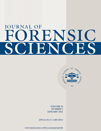Statistical Evidence for the Similarity of the Human Dentition
Abstract
Abstract: Recent scrutiny of forensic science has focused on unreliability of expert witness testimony when based on statements of individuality. In bitemark analysis, assumptions regarding uniqueness of the dentition have been based on use of the product rule while ignoring correlation and nonuniformity of dental arrangement. To examine the effect of these factors, two separate sets of scanned dental models (n = 172 and n = 344) were measured and statistically tested to determine match rates. Results were compared to those of a prior study. Seven and 16 matches of the six anterior lower teeth were found in the respective data sets. Correlations and nonuniform distributions of tooth positions were observed. Simulation tests were performed to verify results. Results indicate that given experimental measurement parameters, statements of dental uniqueness with respect to bitemark analysis in an open population are unsupportable and that use of the product rule is inappropriate.




